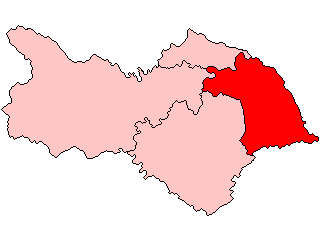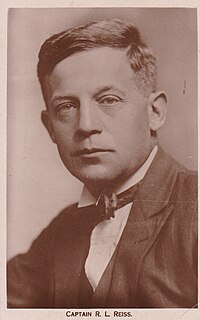
The Scarborough and Whitby by-election was a parliamentary by-election for the British House of Commons constituency of Scarborough and Whitby on 6 May 1931.

The Scarborough and Whitby by-election was a parliamentary by-election for the British House of Commons constituency of Scarborough and Whitby on 6 May 1931.
The by-election was caused by the resignation of the sitting Conservative MP, Sidney Herbert on 20 April 1931. He had been MP here since winning the seat in 1922.
The constituency had always returned Unionists since its creation in 1918. However, the Liberals had come close to winning in 1923. The result at the last General election was also close;
| Party | Candidate | Votes | % | ±% | |
|---|---|---|---|---|---|
| Unionist | Sidney Herbert | 20,710 | 48.3 | ||
| Liberal | Henry Paterson Gisborne | 17,544 | 40.9 | ||
| Labour | H D Rowntree | 4,645 | 10.8 | ||
| Majority | 3,166 | 7.4 | |||
| Turnout | 42,899 | 79.7 | |||
| Unionist hold | Swing | ||||
The local Conservative Association chose 26-year-old Sir Paul Latham as their candidate to defend the seat. He had recently inherited the Latham baronetcy. Latham was a member of the London County Council, representing Lewisham East as a member of the Conservative-backed Municipal Reform Party. [2] [3] At the 1929 general election, he stood as the Conservative candidate in Rotherham, [2] a safe seat for the Labour Party where he was runner-up with 23% of the votes. [4]
The local Liberals put forward 59-year-old Ramsay Muir as their candidate. He was central to Liberal party policy development in the 1920s. Muir was elected at the 1923 general election as Member of Parliament (MP) for Rochdale in Lancashire, having been unsuccessful in that constituency at the 1922 general election However he was defeated at the 1924 election. He stood for Parliament again without success in the 1926 by-election for the Combined English Universities and at the 1929 general election again at Rochdale.
It was apparent from the beginning that there existed a division in the Scarborough Labour Party as to the advisability of putting forward a Candidate. Nevertheless, attempts were made to secure a nomination but without success. A resolution was therefore carried not to enter the contest, which, upon being reported to the National Executive Committee, was endorsed. However, following pressure from the ILP, the local party adopted a Mr Williams as candidate and on 24 April 1931 sought his endorsement by the NEC. However, the NEC refused to endorse him for the following reasons; (a) The first decision of the Divisional Party not to contest, which the Committee had endorsed. (b) The division in the local ranks, which would have prevented an active campaign. (c) A shortage of financial resources. (d) The time factor, as the writ had been issued. The Scarborough Divisional Labour Party loyally abided by the decision of the Executive Committee and did not put forward a Candidate. [5]
Polling day was set for 6 May 1931, just 16 days after the resignation of the previous member.
Lloyd George came to speak for Ramsay Muir twice, once in a hall and once in the Excursion Station and attracted large and enthusiastic audiences. [6]
Latham held the seat. There was a small swing to the Liberals;
| Party | Candidate | Votes | % | ±% | |
|---|---|---|---|---|---|
| Conservative | Paul Latham | 21,618 | 52.7 | +4.4 | |
| Liberal | Ramsay Muir | 19,429 | 47.3 | +6.4 | |
| Majority | 2,189 | 5.4 | -2.0 | ||
| Turnout | 41,047 | 75.5 | -4.2 | ||
| Conservative hold | Swing | -1.0 | |||
Latham held the seat at the 1931 general election. Muir however, contested Louth without success. This left the Liberals without a candidate. Muir returned to contest the 1935 general election to Scarborough and Whitby. The result at the following General election;
| Party | Candidate | Votes | % | ±% | |
|---|---|---|---|---|---|
| Conservative | Paul Latham | 32,025 | 82.97 | ||
| Labour | P S Eastman | 6,575 | 17.03 | ||
| Majority | 25,450 | 65.93 | |||
| Turnout | 38,600 | 69.49 | |||
| Conservative hold | Swing | ||||
Latham's parliamentary career continued until 1941, when he was arrested [7] for "improper behaviour", a homosexual act, with three gunners and a civilian [8] while serving as an officer in the Royal Artillery. [2]

Scarborough and Whitby is a constituency represented in the House of Commons of the UK Parliament since 2005 by Robert Goodwill, a Conservative.

Ormskirk was a county constituency represented in the House of Commons of the Parliament of the United Kingdom. It elected one Member of Parliament (MP) by the first past the post system of election. It was created by the Redistribution of Seats Act 1885 as a division of the parliamentary county of Lancashire. The constituency boundaries were changed in 1918, 1950, 1955 and 1974.
Wednesbury was a borough constituency in England's Black Country which returned one Member of Parliament to the House of Commons of the Parliament of the United Kingdom from 1868 until it was abolished for the February 1974 general election.

Sydney Arnold, 1st Baron Arnold was a radical British Liberal Party politician who later joined the Labour Party and served as a government minister.
Thomas Bridgehill Wilson Ramsay was a Scottish Liberal Party, and National Liberal Party politician and Member of Parliament (MP).
Hyacinth Bernard Wenceslaus Morgan was a Labour Party politician in the United Kingdom. He was a Member of Parliament (MP) from 1929 to 1931, and 1940 to 1955.
The Stockport by-election, 1925 was a by-election held for the British House of Commons constituency of Stockport in Cheshire on 17 September 1925. The by-election was won by the Labour Party candidate Arnold Townend.
The Kilmarnock by-election, 1929 was a by-election held on 27 September 1929 for the British House of Commons constituency of Kilmarnock in Ayrshire.
The Bishop Auckland by-election, 1929 was a parliamentary by-election held on 7 February 1929 for the British House of Commons constituency of Bishop Auckland in County Durham.
The Holland with Boston by-election, 1937 was a parliamentary by-election held on 24 June 1937 for the British House of Commons constituency of Holland with Boston.

John Ramsay Bryce Muir was a British historian, Liberal Party politician and thinker who made a significant contribution to the development of liberal political philosophy in the 1920s and 1930s through his work on domestic industrial policy and his promotion of the international policy of interdependency.

Major Sir Herbert Paul Latham, 2nd Baronet was a British Conservative Party politician who served as Member of Parliament (MP) for Scarborough and Whitby constituency from 1931 to 1941.

Sir Sydney Walter John Robinson JP was an English farmer, building contractor and Liberal politician.
William Hirst was a British Labour Co-operative politician who was the Member of Parliament (MP) for Bradford South from 1924 to 1931.
The Holderness by-election, 1939 was a parliamentary by-election held on 15 February 1939 for the British House of Commons constituency of Holderness in the East Riding of Yorkshire.
The Ashford by-election, 1933 was a parliamentary by-election for the British House of Commons constituency of Ashford on 17 March 1933.
The Bury St Edmunds by-election, 1944 was a parliamentary by-election for the British House of Commons constituency of Bury St Edmunds, Suffolk on 29 February 1944.
The Lancaster by-election, 1941 was a parliamentary by-election for the British House of Commons constituency of Lancaster, Lancashire on 15 October 1941.
The Combined English Universities by-election, 1937 was a parliamentary by-election for the British House of Commons dual member constituency of the Combined English Universities 22 March 1937.

Richard Leopold Reiss, was a British Liberal Party politician who later joined the Labour Party. He was Director of the Hampstead Garden Suburb Trust Ltd. He was awarded the Order of St Olav of Norway. In 1948 he was awarded the Howard Memorial Medal for outstanding services to town planning.